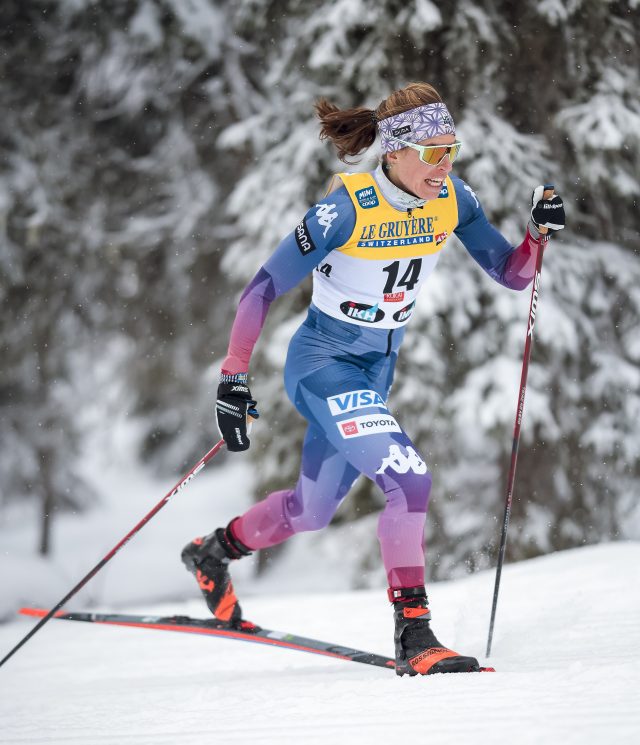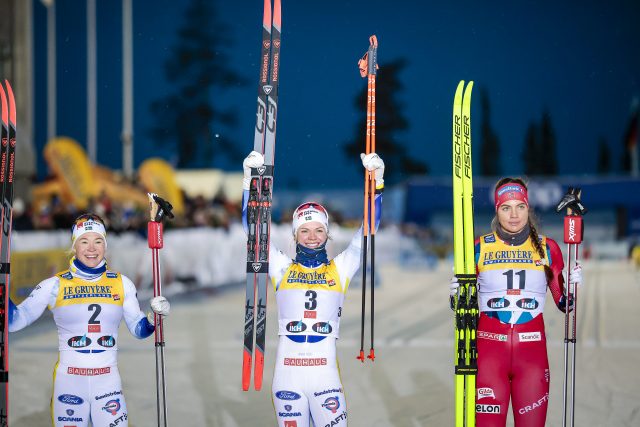 This coverage is made possible through the generous support of Marty and Kathy Hall and A Hall Mark of Excellence Award. Learn more about A Hall Mark of Excellence Award—or about supporting FasterSkier coverage—by contacting info@fasterskier.com.
This coverage is made possible through the generous support of Marty and Kathy Hall and A Hall Mark of Excellence Award. Learn more about A Hall Mark of Excellence Award—or about supporting FasterSkier coverage—by contacting info@fasterskier.com.

Today, in the near perpetual darkness of Finland’s early winter, the classic sprint competition announced the dawn of the new World Cup season. The new season brings with it a new rule—perhaps the most significant rule change since skating was allowed—the much awaited fluoro ban, and the associated anxiety over testing protocols. Also affecting race outcomes is the continuing Russia ban.
But the more things change, the more they stay the same in women’s sprinting. Emma Ribom (SWE) repeated last year’s victory taking the classic sprint title in Ruka for the second year in a row. Sweden also continued its domination of women’s sprinting placing four skiers into the finals with Jonna Sundling taking second. Norway only placed one skier into the finals, Kristine Skistad, but it was enough to find the podium as Skistad took third. Skistad picked up where she left off from last season having had a tremendous late season showing having won the last four sprint events last year.
The American contingent had a good day placing three skiers into the heats. Rosie Brennan, qualified 8th, Julia Kern qualified,18th, and Jessie Diggins qualified 12th. Other Americans who did not qualify were Novie McCabe finishing 43rd, and Lauren Jortberg finishing 45th. Canadians Katherine Stewart-Jones finished 40th, and Amelia Wells finished 46th.

All three American qualifiers performed well in their heats and moved into the semis; for a while, it looked like there might be a strong American presence in the finals. But then the Swedish freight train asserted its dominance.
Kern and Brennan were together in the first semifinal, but couldn’t push through to the top. Kern finished fourth and Brennan finished fifth. Kern nearly advanced to the finals as her time tied her for a lucky loser spot to the hundredth of a second, but due to a complex tie-breaking formula she was unable to advance. Kern finished eighth overall and Brennan ninth.

Diggins looked great in her quarterfinal, crushing the field in her heat and setting expectations high by putting up the fastest quarterfinal time of the day. She looked strong at the start of her semifinal—leading at the half-way point—but couldn’t sustain the pace and failed to advance out of the semifinal. She would finish seventh overall.
It was a good day for team USA with the team’s coach, Matt Whitcomb, describing the team’s performance as “better than expected. This exceeded our average Ruka day.” Whitcomb pointed out that on the first day of racing the American team might be at a bit of a disadvantage. “I don’t like to make excuses,” he said. “But the Scandinavians have been racing already for a while longer than we have.”
The day clearly belonged to Team Sweden despite the shocking debut of last year’s crystal globe sprint winner, Maja Dahlqvist (SWE), who failed to qualify for the heats. When all was said and done, Sweden showed it’s still the team to beat in women’s sprinting, and the Americans continued to be knocking on the podium door.
The biggest non-story of the day was day one of racing with the fluoro ban. No one was sanctioned for a fluoro infraction and the cold snow rendered the lack of fluoros a non-issue. This outcome was due to the hard work of all teams’ wax technicians. “Today we were really seeking to nail the process with everyone getting their first starts under their belts,” Whitcomb said. “Our stress meters were slightly higher than normal.” Whitcomb was able to provide insight into the new fluoro protocols. “We’re nervous about this [new fluoro rules], but FIS has really done their homework.”
“Yesterday, our whole team showed up at 3:00 p.m.” Whitcomb continued. “And we did a dry run of the entire process.” Whitcomb also shared that some of the major ski powers have their own fluoro testing machines, which cost about $30,000 a piece, which the U.S. does not have the resources for. He mentioned that the Austrians were generous enough to loan the American’s their machine for two days to test all of their skis.
Whitcomb described the race day testing protocol: “Skis are tested before and after racing with different tolerances for before and after a race to allow for post race contamination,” he said. “For sprints, skis are tested before qualifications. Skis are then tested after qualification and we can take them back to the truck to re-wax for the heats. For the heats, they’re tested again before the quarterfinals, and after the finals. For a classic race, an athlete can bring two pairs of skis to the start, have them both tested, and then choose which pair to race on. Clean tested skis are held in a green zone which FIS and volunteers control. If a tested ski exits the green zone or the race course, they are out for the day. On classic race days, techs are allowed to modify kick wax, under FIS supervision, while skis are in the green zone.”
It’s a lot to process, but teams and racers seem to have adjusted well. It’s been a lot of work. Whitcomb said they spent three weeks just cleaning the wax truck, including scrubbing down light bulbs. It certainly isn’t the end of the fluoro story, though. Whitcomb pointed out that skis with deeper structure which have been used for warm conditions can be cleaned, but that fluoros can rise out later and a ski can fail the test. If a ski tests positive, the racer is disqualified for the day. “As I understand it, if any of the skiers’ sets of skis test positive, that skier is not permitted to start.”
It’s a brave new world for waxing, but for day one, it went off without any glitches.
Women’s Classic Sprint RESULTS




